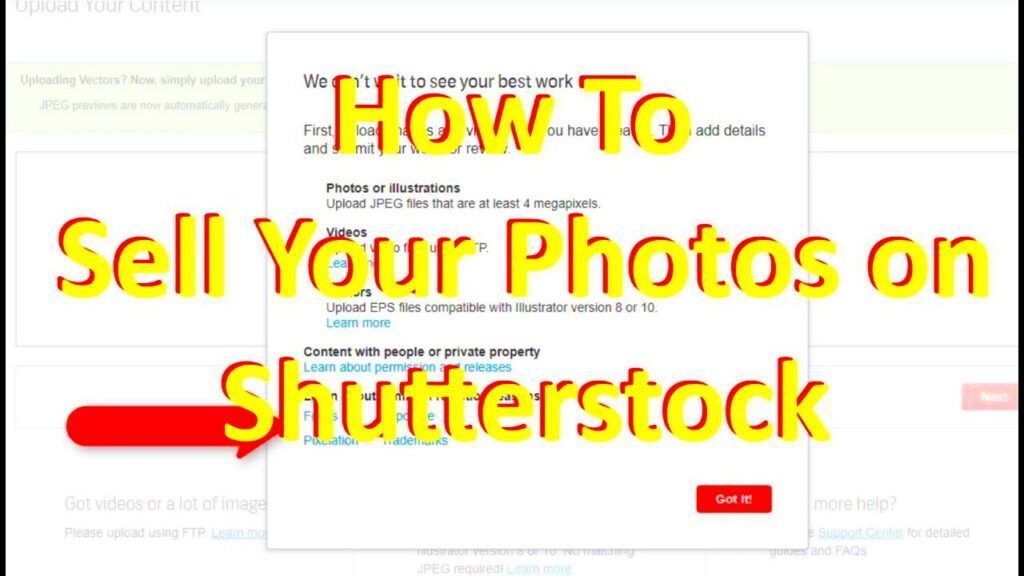Before you start selling photos on Shutterstock, it's essential to grasp how the platform works and who your potential buyers are. Shutterstock is a vast online marketplace that connects photographers and artists with businesses, designers, and content creators looking for high-quality images. Understanding your audience helps you create images that meet their needs.
Your target audience might include:
- Marketing agencies looking for images for advertisements
- Bloggers needing visuals for their posts
- Businesses requiring images for their websites and brochures
By knowing who you’re selling to, you can tailor your photos to fit their specific requirements, increasing your chances of making a sale.
Prepare Your Photos for Submission

Preparation is key when submitting photos to Shutterstock. Quality matters, so take time to ensure your images are top-notch. Here are some tips to help you:
- Use High-Resolution Images: Make sure your photos are high resolution (at least 4 MP) to meet Shutterstock's standards.
- Edit Your Photos: Use editing software to enhance colors, contrast, and sharpness. However, avoid over-editing.
- Ensure Proper Composition: Follow photography rules like the rule of thirds and leading lines to create appealing images.
- Include Variety: Capture different angles, perspectives, and subjects to appeal to a broader audience.
Once you have a collection of quality images, you'll be ready to submit them to the platform.
Also Read This: How to View YouTube Likes and Dislikes – A Complete Guide
Use Relevant Keywords and Tags
Keywords and tags are crucial for making your photos discoverable on Shutterstock. When buyers search for images, they use specific terms, so including the right keywords can significantly boost your visibility. Here’s how to effectively use keywords and tags:
- Research Popular Keywords: Use tools like Google Keyword Planner or Shutterstock’s search bar to find relevant keywords.
- Be Specific: Instead of using generic terms like “flower,” try more specific ones like “red rose in sunlight.”
- Utilize All Tag Slots: Shutterstock allows you to add multiple tags; use them all to enhance searchability.
- Think Like a Buyer: Consider what terms your target audience might use when looking for images similar to yours.
By carefully selecting your keywords and tags, you increase the chances of your photos appearing in search results, leading to more sales.
Also Read This: Best Adblockers for YouTube in 2024
Set Competitive Prices for Your Photos
Setting the right price for your photos on Shutterstock can make a significant difference in your sales. While you want to earn a fair return for your work, it’s also crucial to stay competitive in a crowded market. Here’s how you can approach pricing your photos effectively:
- Research the Market: Take time to browse similar images on Shutterstock. Note the prices of photos that are similar in style and quality to yours.
- Consider Image Quality: Higher-quality images often command higher prices. Ensure your photos are polished and professional to justify your price point.
- Factor in Your Costs: Think about the time, effort, and resources you invested in capturing and editing your photos. Ensure your price reflects this.
- Utilize Pricing Models: Shutterstock offers different pricing tiers based on licenses. Familiarize yourself with these options to choose what works best for your photos.
Ultimately, finding a balance between competitiveness and value is key. Regularly reassess your pricing strategy based on your sales performance and market trends.
Also Read This: A Comprehensive Guide to Crafting Presentations with Behance Templates
Promote Your Photos on Social Media
In today's digital age, social media is a powerful tool for promoting your photos. By sharing your work across various platforms, you can reach a wider audience and drive traffic to your Shutterstock portfolio. Here are some tips for effective promotion:
- Choose the Right Platforms: Focus on platforms where visual content thrives, such as Instagram, Pinterest, and Facebook. Tailor your content for each platform.
- Create Engaging Posts: Use captivating captions, hashtags, and tags to attract attention. Share behind-the-scenes looks or stories about your photography journey.
- Join Photography Groups: Participate in online communities and forums where photographers and buyers gather. Share your work and engage with others.
- Collaborate with Influencers: Partner with social media influencers who align with your style. They can help showcase your work to their audience.
Remember to include links to your Shutterstock portfolio in your bio or posts. This way, interested viewers can easily find and purchase your images.
Also Read This: How Much Is One Image on Shutterstock
Engage with the Shutterstock Community
Engaging with the Shutterstock community is a great way to increase your visibility and build relationships with other artists and potential buyers. Here are some effective ways to connect:
- Participate in Forums: Join discussions on Shutterstock’s community forums. Share your experiences, ask questions, and provide support to other contributors.
- Follow Other Contributors: Discover and follow other photographers. Engaging with their work can lead to mutual support and collaboration.
- Attend Webinars and Events: Shutterstock often hosts webinars and events for contributors. Attend these to learn more and network with others in the community.
- Seek Feedback: Don't hesitate to ask fellow photographers for feedback on your work. Constructive criticism can help you improve and grow as a creator.
Building connections within the community not only enhances your experience but can also lead to new opportunities and increased sales.
Also Read This: Central Purpose of Fortiguard Downloader Labs
Analyze Your Sales Data for Improvement
Once you start selling your photos on Shutterstock, it's vital to keep track of your sales data. Analyzing this information helps you understand what works and what doesn't, allowing you to refine your approach and boost your sales. Here’s how to effectively analyze your sales data:
- Check Your Dashboard Regularly: Shutterstock provides a dashboard where you can see your earnings, downloads, and views. Make it a habit to check this data regularly.
- Identify Trends: Look for patterns in your sales. Are certain types of images selling better than others? Identifying these trends can help you focus on popular subjects.
- Evaluate Your Tags: If certain images are not getting downloads, consider if your keywords and tags are effective. You may need to revise them to improve visibility.
- Review Seasonal Trends: Some images may sell better at different times of the year. For example, holiday-themed images often see spikes in sales during the holiday season.
By continually analyzing your sales data, you can adapt your strategy, focus on high-performing images, and ultimately improve your sales on Shutterstock.
Also Read This: How to Submit Your Photos to Getty Images for Aspiring Contributors
FAQs About Selling Photos on Shutterstock
When it comes to selling photos on Shutterstock, you might have several questions. Here are some frequently asked questions to help clarify common concerns:
- How do I submit my photos? You can submit your photos through the Shutterstock Contributor dashboard. Just create an account and upload your images.
- What are the payment options? Shutterstock pays contributors through PayPal, Payoneer, or bank transfer, depending on your location.
- Can I sell the same photos on other platforms? Yes, you can sell your photos on multiple platforms, but make sure to check the licensing agreements.
- How much can I earn per photo? Earnings vary based on the type of license sold. You can earn anywhere from 15% to 40% of the sale price.
If you have more questions, visiting the Shutterstock Help Center or engaging with the community can provide additional support.
Conclusion and Next Steps
Now that you have a roadmap for selling your photos on Shutterstock, it's time to take action. Remember, success doesn’t happen overnight. It takes time, effort, and a bit of patience. Here’s a quick recap of the steps to follow:
- Understand the platform: Know who your audience is and what they need.
- Prepare quality images: Ensure your photos are high-resolution and well-edited.
- Use keywords wisely: Make your images easy to find with relevant tags.
- Set competitive prices: Research and adjust your prices based on market trends.
- Promote your work: Utilize social media to showcase your photos.
- Engage with the community: Build connections and learn from other photographers.
Take these steps, analyze your progress, and continue learning. The more you put into it, the more you can get out of your photography journey on Shutterstock. Good luck!
